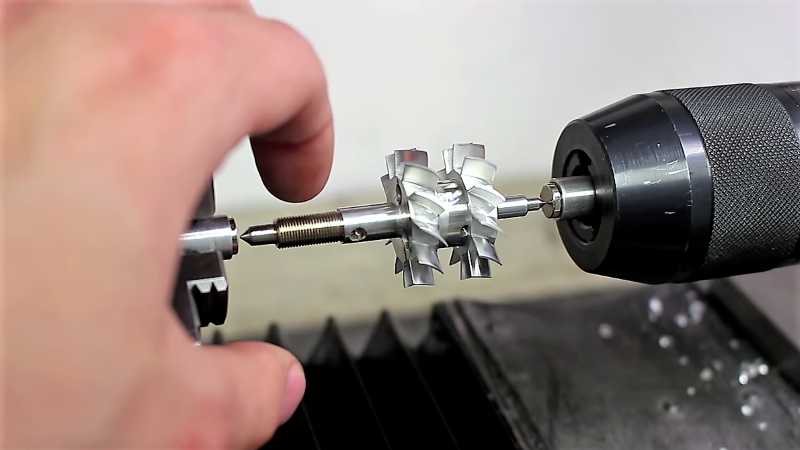We love to see projects revisited, especially when new materials or methods make it worth giving the first design another go around. This twin-turbine vacuum-powered Dremel tool is a perfect example of what better tools can do for a build.
You may recall [JohnnyQ90]’s first attempt at a vacuum powered rotary tool. That incarnation, very similar in design to the current work, was entirely 3D-printed, and caused no little controversy in the comments about the wisdom of spinning anything made on an FDM printer at 43,000 RPM. Despite the naysaying, [Johnny] appears to have survived his own creation. But the turbo-tool did have its limitations, including somewhat anemic torque. This version, machined rather than printed and made almost completely from aluminum, seems to have solved that problem, perhaps thanks to the increased mass of the rotating parts. The twin rotors and the stator were milled with a 5-axis CNC machine, which has been a great addition to [JohnnyQ90]’s shop. The turbine shaft, looking like something from a miniature jet engine, was meticulously balanced using magnets mounted in the headstock and tailstock of a lathe. The video below shows the build and a few tests; we’re not big fans of the ergonomics of holding the tool on the end of that bulky hose, but it sure seems to work well. And that sound!
We first noticed [JohnnyQ90] when he machined aluminum from soda cans to make a mini Tesla turbine. His builds have come a long way since then, and we look forward to what he’ll come up with next.
















I have never seen anyone dynamically balance using magnets. Really impressive build!
magnet balancing is quite common in the r/c field– the most common setups are for prop balancing.
i suspect that it’s not as common in other area’s simply because the mass to be balanced is typically heavier.
I’m sorry to be that guy, but technically what Johnny is doing in the video is statically balancing, not dynamically balancing the rotor. Dynamically balancing requires spinning a part at speed to measure the vibrations.
I have also never seen the magnet trick before. It looks really convenient for statically balancing small steel parts.
Is it common to use super glue to temporarily hold Aluminum parts for machining?
I was expecting things to go flying.
Yes, very common for delicate, small parts work. Youtube channels that sometimes feature this technique include: Clickspring, Joe Pieczynski, AvE, Alec Steel etc… You need to be careful with feeds and speeds of course, but it’s generally quite safe. Heat the part a little with a blowtorch to release the glue, solvents to remove residue.
NYC CNC does it all the time as well. They used to use painter’s tape but moved on to a green translucent tape – similar to Kapton but green.
Awesome build, and as a bonus, the final tool looks almost viable.
One questions though: does this tool is marketable? At the end, isn’t it cheaper to strap a universal motor than having precise parts manufactured (rotor could be injected for mass production), and requires the user to have a vacuum cleaner?
> At the end, isn’t it cheaper to strap a universal motor than having precise parts manufactured
Yes, it’s way cheaper. But when you try to go that extra length and have precise parts, you can do some innovative things, like dyson bladeless fans (with small but VERY fast precise machined turbine which works outside hearing range). With improved tools go improved parts and with those come new capabilities which you just were not able to obtain previously. That’s how progress is made.
A direct drive with an universal motor is also much more energy efficient than driving a turbine with a vacuum cleaner.
Nice build. But I am skeptical about one thing. Tool creates dust. And vacuum sucks dust. Won’t this dust fill and destroy the turbine?
I did wonder about this, I imagine the fine and non damaging dust would pass through and the larger bits with more mass and damage potential would be thrown clear.
Only time will tell.
That’s a beautiful revision.
The only trouble I had with his original 3d printed version was the bearings filling with dust and seizing.
The blades had so much flow and clearance that debris never hung around long enough to be a problem.
It looks like he’s using much more robust seals on his bearings now, and he seems to have tweaked the flow around them to keep them a touch cleaner.
The 3dp sleeve could be modified to include a shroud/shield added in front of the vane intakes. Feed the vane intakes from a side-port instead of face-on, and when the sleeve is twisted “more open”, feed-thru’s from the front of the shroud could vacuum up more waste.
I’d try compressed air , pressure regulated to vary the speed. No dust in the turbine then.
This is smart ! A vacuum cleaner with an electric regulator, won’t need this speed adaptator.
“The video below shows the build and a few tests; we’re not big fans of the ergonomics of holding the tool on the end of that bulky hose, but it sure seems to work well. And that sound!”
Dremel makes an extension cable so one doesn’t have to hold the motor, just the actual tool.
That’s true, forgot about that. I think I even have one lying around here someplace. It would greatly improve the ergonomics and keep the turbine from ingesting dust and chips. But honestly, I think he wants to suck up some of the debris. Maybe not large chips, but fine dust like from MDF or ceramic tile would probably be fine going by the turbines.
The efficiency of this thing must be terrible. For a 500 Watt shop vac, I would be surprised if it gets 50W out of the shaft.